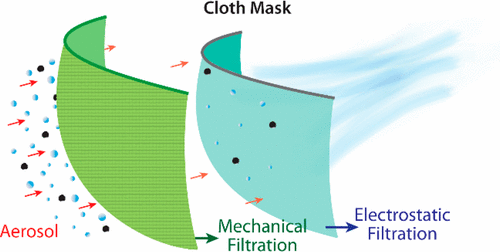But, really, unless you are a healthcare worker, the kind of covering makes little difference. Even if you do spend the money for silk, you are unlikely to have a homemade mask fit well enough it is superior to a bandana. And if you are someone who touches your face often, they are all less effective. Your eyes are not covered. Critics are not wrong for wondering if homemade masks are more than placebo, since aerosols can easily slip through gaps in many cloth fibers.
SARS-CoV-2, the recent coronavirus that causes COVID-19, is in the same family as the common cold, so it is spread mainly through respiratory droplets when an infected person coughs, sneezes, speaks or breathes. When it comes to COVID-19 that will most often be a cough.
The droplets are in a wide range of sizes but aerosols, the tiniest ones, can linger in the air for up to 45 minutes.

Credit: DOI:10.1021/acsnano.0c03252
Supratik Guha at the University of Chicago and colleagues wanted to study the ability of common fabrics, alone or in combination, to filter out aerosols similar in size to respiratory droplets. They used an aerosol mixing chamber to produce particles ranging from 10 nm to 6 μm in diameter. A fan blew the aerosol across various cloth samples at an airflow rate corresponding to a person's respiration at rest, and the team measured the number and size of particles in air before and after passing through the fabric. One layer of a tightly woven cotton sheet combined with two layers of polyester-spandex chiffon -- a sheer fabric often used in evening gowns -- filtered out the most aerosol particles (80-99%, depending on particle size), with performance close to that of an N95 mask material.
Substituting the chiffon with natural silk or flannel, or simply using a cotton quilt with cotton-polyester batting, produced similar results.
The researchers point out that tightly woven fabrics, such as cotton, can act as a mechanical barrier to particles, whereas fabrics that hold a static charge, like certain types of chiffon and natural silk, serve as an electrostatic barrier. However, a 1% gap reduced the filtering efficiency of all masks by half or more, emphasizing the importance of a properly fitted mask.






Comments